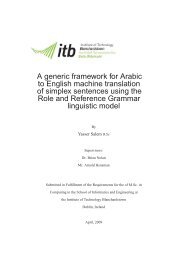On the occurrence and consequences of inaccurate ... - Acsu Buffalo
On the occurrence and consequences of inaccurate ... - Acsu Buffalo
On the occurrence and consequences of inaccurate ... - Acsu Buffalo
You also want an ePaper? Increase the reach of your titles
YUMPU automatically turns print PDFs into web optimized ePapers that Google loves.
E.R. Odders-White / Journal <strong>of</strong> Financial Markets 3 (2000) 259}286 265<br />
1991. The TORQ data consist <strong>of</strong> transaction, quote, <strong>and</strong> order records for all<br />
orders placed through one <strong>of</strong> <strong>the</strong> automated routing systems, as well as audit<br />
trail data, providing information on <strong>the</strong> parties involved <strong>and</strong> o<strong>the</strong>r detailed<br />
information about <strong>the</strong> trades.<br />
Before <strong>the</strong> Lee <strong>and</strong> Ready algorithms are evaluated, <strong>the</strong> true classi"cation <strong>of</strong><br />
each transaction is determined using a two-step process. In <strong>the</strong> "rst step,<br />
transaction records from <strong>the</strong> TORQ audit "le are matched with order execution<br />
records from <strong>the</strong> TORQ order "le, which contain <strong>the</strong> dates <strong>and</strong> times at which<br />
<strong>the</strong> executed orders were placed, as well as <strong>the</strong> order types (market, limit, or<br />
nonst<strong>and</strong>ard). This information is <strong>the</strong>n used in <strong>the</strong> second step to identify <strong>the</strong><br />
initiator <strong>of</strong> each transaction according to <strong>the</strong> de"nition in Section 1, by comparing<br />
<strong>the</strong> order dates <strong>and</strong> times for <strong>the</strong> buy <strong>and</strong> sell sides <strong>of</strong> <strong>the</strong> transaction. For<br />
example, if <strong>the</strong> sell order is placed on November 1, <strong>and</strong> <strong>the</strong> buy order is placed<br />
on November 2, <strong>the</strong>n <strong>the</strong> trade is buyer-initiated. Because <strong>the</strong> concept <strong>of</strong> an<br />
initiator is not applicable at <strong>the</strong> open (due to <strong>the</strong> opening auction), transactions<br />
occurring during <strong>the</strong> "rst 15 min <strong>of</strong> trading are excluded from <strong>the</strong> analysis.<br />
Some transaction records cannot be matched with order execution records<br />
because at least one <strong>of</strong> <strong>the</strong> orders was not placed through an automated routing<br />
system. (For example, <strong>the</strong> order(s) may have been placed by a #oor broker.) As<br />
a result, corresponding order execution records do not exist, <strong>and</strong> order information<br />
is not available for <strong>the</strong>se transactions. Table 1 contains a breakdown <strong>of</strong> <strong>the</strong><br />
magnitude <strong>of</strong> this problem by "rm size. Panel A presents both <strong>the</strong> number <strong>and</strong><br />
<strong>the</strong> percentage <strong>of</strong> transaction records for which <strong>the</strong> true initiator cannot be<br />
determined. Overall, <strong>the</strong> true initiator is unknown for 25.1% <strong>of</strong> <strong>the</strong> transactions.<br />
Panel B contains <strong>the</strong> number <strong>and</strong> percentage <strong>of</strong> buy <strong>and</strong> sell order execution<br />
records that remain unmatched, again broken down by "rm size. Note that for<br />
<strong>the</strong> entire sample, <strong>the</strong>re are only 4802 unmatched order execution records (2505<br />
buys <strong>and</strong> 2297 sells), while <strong>the</strong>re are 106,413 unclassi"ed transaction records.<br />
This con"rms that <strong>the</strong> true initiator cannot be determined for <strong>the</strong>se transaction<br />
records primarily due to <strong>the</strong> lack <strong>of</strong> corresponding order execution records.<br />
Without <strong>the</strong> order date <strong>and</strong> time, <strong>the</strong> true initiator <strong>of</strong> <strong>the</strong> transaction cannot be<br />
determined. Transactions for which nei<strong>the</strong>r <strong>the</strong> buy nor <strong>the</strong> sell quantities were<br />
compared (agreed upon by both parties) also remain unclassi"ed. Such transactions<br />
account for 4.1 <strong>of</strong> <strong>the</strong> 25.1%.<br />
In <strong>the</strong> "nal step, <strong>the</strong> quote <strong>and</strong> tick algorithms, as well as <strong>the</strong> Lee <strong>and</strong> Ready<br />
algorithm, are applied to <strong>the</strong> transaction data to obtain <strong>the</strong> estimated classi"cations.<br />
Transactions for which <strong>the</strong> initiator cannot be determined are eliminated<br />
from <strong>the</strong> sample after <strong>the</strong> trade classi"cation algorithms are applied. The<br />
resulting classi"cations are <strong>the</strong>n compared to <strong>the</strong> true classi"cation for each<br />
trade.<br />
For a description <strong>of</strong> <strong>the</strong> TORQ database, see Hasbrouck (1992).
















